
|
|
|
|
|
|
|
|
|
|
Passer Angelfish
|
|
|
|
|
|
|
|
Adult Passer Angelfish Holacanthus passer 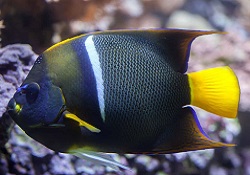 Identification: The Adult Passer Angelfish (Holacanthus passer) are beautiful fish. Also called the King Angelfish and Whitebanded Angelfish, they come from the Eastern Pacific, including the Gulf of California to Peru and the Galapagos Islands. The adult is mostly dark blue with a white vertical stripe extending down from the dorsal fin towards the pelvic fin. The dorsal fin is trimmed in yellow and the caudal and pectoral fins are yellow. The ventral fins are yellow on a female and white on the male. Holacanthus passer is a handsome fish with a “crown”, thus its royal designation. The Passer Angelfish is very hardy, so it can be suggested for the beginner aquarist. Its close relative the Queen Angelfish, Holacanthus ciliaris also has a "crown" and a similar body structure, but these two do differ slightly in size and in coloration. Although Passers have been found as large as 14" in length, 9" to 10" is more common. They can have a lifespan of 20 years or more with proper care. The feeding habits of the Passer is quite extraordinary. Like other species of Holacanthus they feed mostly on sponges, algae, plankton, and other invertebrates, but both juveniles and adults also perform cleaning services. Juveniles will set up cleaning stations and remove ecto parasites from a variety of fish including groupers, grunts, snappers, and goat fishes. But adults will actually clean parasites from Hammerhead Sharks and Manta Rays! TankRecommendations: Provide a 125 gallon or larger tank with large amounts of live rock for hiding and grazing on micro fauna. Food and diet: The Passer is an omnivore. In the wild juveniles feed mostly on filamentous algae, but are also known to clean external parasites from other fish. Adults feed on algae and sponges, as well as smaller amounts of invertebrate eggs, cnidarians, zooplankton, and parasites from other fish. It's a grazer, so plenty of live rock with natural macro algae growing on the surface is very important for their health with a small amount of meaty foods. Juveniles eat more algae than adults, thus foods while juveniles should have a greater content of algae and other vegetables. In the aquarium feed a diet with a wide variety of vegetable materials. Provide foods that have sponge material and Spirulina in the formula. The quality of the food is important and any flake or pellet foods you choose should contain sponge material and Spirulina. They love Nori and will eat the various colors of dried algae sheets, and frozen preparations. They can also be offered fresh uncooked broccoli which will provide them with vitamin A and C. Adding caulerpa to the tank is also appreciated. There are several good commercial foods available as well, including Formula II and Angel Formula. You may also supplement their diet with a very small amount of meaty fare such as brine and mysis shrimps, along with finely chopped marine flesh. Use meaty foods sparingly. If you have carnivorous fish housed with this angelfish, feed the tank with vegetable based foods first to give the angelfish their fill. Then when meaty foods are added the angelfish will be pretty full and will not consume high levels of meaty foods. Feed several small meals a day, rather than one large meal daily. Offer 2 to 3 feedings a day with only an amount that can be consumed in about 5 minutes. Left over food should be removed to keep water quality high. Level of Care: Beginner Acclimaton Time: 3+ hours Reef Compatibility : Not Reef Safe, will damage sessile invertebrates, stony and soft corals, and clam mantles. Adult Size: Medium: 2-1/2" to 4", Medium/Large 4" to 5", Large: 5" to 6", XL 6" to 7", XXL 7" to 8", XXXL 8" to 10", Show 10" to 12" XLarge $499.00 XXLarge $599.00 XXXLarge $699.00 Show Size $899.0 |
Juvenile Passer Angelfish Holacanthus passer 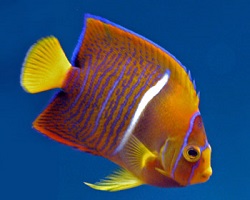 Identification: The Juvenile Passer Angelfish (Holacanthus passer) are beautiful fish. They come from the Eastern Pacific, including the Gulf of California to Peru and the Galapagos Islands. The Juvenile is mostly dark orange to a rust color, with a white vertical stripe extending down from the dorsal fin towards the pelvic fin. The dorsal fin is trimmed in yellow and the caudal and pectoral fins are yellow. Juvenile Passer Angelfish look very similar to Juvenile Clarion Angelfish and can be easily confused for each other unless seen side by side. The feeding habits of the Juvenile and adult Passer are similar. They feed mostly on sponges, algae, plankton, and other invertebrates, but like the adults, Juveniles perform cleaning services. Juveniles will set up cleaning stations and remove ecto parasites from a variety of fish including groupers, grunts, snappers, and goat fishes. Tank Recommendations: Provide a Juvenile Passer Angel is fine in a 100 gallon tank. But we recommend a larger tank since they will slowly grown and require it. Either size it needs to have large amounts of live rock for hiding and grazing on micro fauna. Food and diet: The Passer is an omnivore. In the wild juveniles feed mostly on filamentous algae, but are also known to clean external parasites from other fish. Juveniles feed on algae and sponges, as well as smaller amounts of invertebrate eggs, cnidarians, zooplankton, and parasites from other fish. It's a grazer, so plenty of live rock with natural macro algae growing on the surface is very important for their health with a small amount of meaty foods. Juveniles eat more algae than adults, thus foods while juveniles should have a greater content of algae and other vegetables. In the aquarium feed a diet with a wide variety of vegetable materials. Provide foods that have sponge material and Spirulina in the formula. The quality of the food is important and any flake or pellet foods you choose should contain sponge material and Spirulina. They love Nori and will eat the various colors of dried algae sheets, and frozen preparations. They can also be offered fresh uncooked broccoli which will provide them with vitamin A and C. Adding caulerpa to the tank is also appreciated. There are several good commercial foods available as well, including Formula II and Angel Formula. You may also supplement their diet with a very small amount of meaty fare such as brine and mysis shrimps, along with finely chopped marine flesh. Use meaty foods sparingly. If you have carnivorous fish housed with this angelfish, feed the tank with vegetable based foods first to give the angelfish their fill. Then when meaty foods are added the angelfish will be pretty full and will not consume high levels of meaty foods. Feed several small meals a day, rather than one large meal daily. Offer 2 to 3 feedings a day with only an amount that can be consumed in about 5 minutes. Left over food should be removed to keep water quality high. Level of Care: Beginner Acclimaton Time: 3+ hours Reef Compatibility : Not Reef Safe, will damage sessile invertebrates, stony and soft corals, and clam mantles. Approximate Size: Juvenile: Tiny 1" to 2", Small 2" to 2-1/2" |
Lamarck Angel, Female Genicanthus lamarck 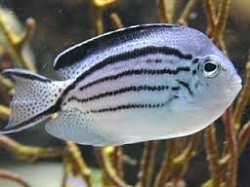 Identification: The Lamarck's Angelfish, Genicanthus lamarck, is one of the swallowtail angels within the Genicanthus genus. Males and Females have this teardrop shape and the males have this long flowing filaments extending off the tail fin. Males and Females are a silvery-white color with horizontal black stripes from eye to caudal fin. The females have bolder stripes and their's one extending all the way into,and covering the length of the caudal fin. In both male and female's the long dorsal fin is black, larger with the female and the caudal fin peppered with black. Full size they will need a good size aquarium, reaching up to 9.9 inches. TankRecommendations: The Lamarck Angels are easier to keep healthy than many other angels. Provide a 125 gallon or larger tank with large amounts of live rock for hiding and grazing on micro fauna. Food and diet: The Lamarck's Angelfish is an omnivore. In the wild juveniles feed mostly on filamentous algae, but are also known to clean external parasites from other fish. Adults feed on algae and sponges, as well as smaller amounts of invertebrate eggs, cnidarians, zooplankton, and parasites from other fish. It's a grazer, so plenty of live rock with natural macro algae growing on the surface is very important for their health with a small amount of meaty foods. Juveniles eat more algae than adults, thus foods while juveniles should have a greater content of algae and other vegetables. In the aquarium feed a diet with a wide variety of vegetable materials. Provide foods that have sponge material and Spirulina in the formula. The quality of the food is important and any flake or pellet foods you choose should contain sponge material and Spirulina. They love Nori and will eat the various colors of dried algae sheets, and frozen preparations. They can also be offered fresh uncooked broccoli which will provide them with vitamin A and C. Adding caulerpa to the tank is also appreciated. There are several good commercial foods available as well, including Formula II and Angel Formula. You may also supplement their diet with a very small amount of meaty fare such as brine and mysis shrimps, along with finely chopped marine flesh. Use meaty foods sparingly. If you have carnivorous fish housed with this angelfish, feed the tank with vegetable based foods first to give the angelfish their fill. Then when meaty foods are added the angelfish will be pretty full and will not consume high levels of meaty foods. Feed several small meals a day, rather than one large meal daily. Offer 2 to 3 feedings a day with only an amount that can be consumed in about 5 minutes. Left over food should be removed to keep water quality high. Level of Care: Moderate Acclimaton Time: 3+ hours Reef Compatibility : Yes Size: Small 1" to 2"; Medium 2" to 3-1/4"; Large 3-1/4" to 4-1/2" Small $69.99 Medium$79.99 Large $89.99 |
|
Lamarck Angel, Male Genicanthus lamarck 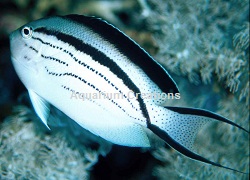 Identification: The Lamarck's Angelfish, Genicanthus lamarck, is one of the swallowtail angels within the Genicanthus genus. Males and Females have this teardrop shape and the males have this long flowing filaments extending off the tail fin. Males and Females are a silvery-white color with horizontal black stripes from eye to caudal fin. The females have bolder stripes and their's one extending all the way into,and covering the length of the caudal fin. In both male and female's the long dorsal fin is black, larger with the female and the caudal fin peppered with black. Full size they will need a good size aquarium, reaching up to 9.9 inches. TankRecommendations: The Lamarck Angels are easier to keep healthy than many other angels. Provide a 125 gallon or larger tank with large amounts of live rock for hiding and grazing on micro fauna. Food and diet: The Lamarck's Angelfish is an omnivore. In the wild juveniles feed mostly on filamentous algae, but are also known to clean external parasites from other fish. Adults feed on algae and sponges, as well as smaller amounts of invertebrate eggs, cnidarians, zooplankton, and parasites from other fish. It's a grazer, so plenty of live rock with natural macro algae growing on the surface is very important for their health with a small amount of meaty foods. Juveniles eat more algae than adults, thus foods while juveniles should have a greater content of algae and other vegetables. In the aquarium feed a diet with a wide variety of vegetable materials. Provide foods that have sponge material and Spirulina in the formula. The quality of the food is important and any flake or pellet foods you choose should contain sponge material and Spirulina. They love Nori and will eat the various colors of dried algae sheets, and frozen preparations. They can also be offered fresh uncooked broccoli which will provide them with vitamin A and C. Adding caulerpa to the tank is also appreciated. There are several good commercial foods available as well, including Formula II and Angel Formula. You may also supplement their diet with a very small amount of meaty fare such as brine and mysis shrimps, along with finely chopped marine flesh. Use meaty foods sparingly. If you have carnivorous fish housed with this angelfish, feed the tank with vegetable based foods first to give the angelfish their fill. Then when meaty foods are added the angelfish will be pretty full and will not consume high levels of meaty foods. Feed several small meals a day, rather than one large meal daily. Offer 2 to 3 feedings a day with only an amount that can be consumed in about 5 minutes. Left over food should be removed to keep water quality high. Level of Care: Moderate Acclimaton Time: 3+ hours Reef Compatibility : Yes Size: Small 1" to 2"; Medium 2" to 3-1/4"; Large 3-1/4" to 5-1/2" Small $199.99 Medium$299.99 Large $399.99 |
Venustus Angel Centropyge venustus 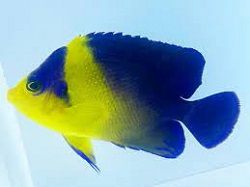 Identification: Venustus Angelfish (Centropyge venustus) is also known as Purple Masked Angelfish, Blue-Backed Angelfish, and Purplemask Angelfish. Its striking contrast of Blue and Yellow under aquarium lights is amazing. The Venustus or Purple Masked Angelfish is a rare dwarf angelfish, not in stock that often, it's perfect for the aquarist that's looking for a showy angel in a small package. All Aquarium Creations fish have been resting, acclimated to aquarium conditions, ensuring a helthy, quality animal. TankRecommendations: Provide a 60 gallon or larger tank with large amounts of live rock for hiding and grazing on micro fauna. Food and diet: The Venustus Angelfish is an omnivore. In the wild juveniles feed mostly on filamentous algae, but are also known to clean external parasites from other fish. Adults feed on algae and sponges, as well as smaller amounts of invertebrate eggs, cnidarians, zooplankton, and parasites from other fish. It's a grazer, so plenty of live rock with natural macro algae growing on the surface is very important for their health with a small amount of meaty foods. Juveniles eat more algae than adults, thus foods while juveniles should have a greater content of algae and other vegetables. In the aquarium feed a diet with a wide variety of vegetable materials. Provide foods that have sponge material and Spirulina in the formula. The quality of the food is important and any flake or pellet foods you choose should contain sponge material and Spirulina. They love Nori and will eat the various colors of dried algae sheets, and frozen preparations. They can also be offered fresh uncooked broccoli which will provide them with vitamin A and C. Adding caulerpa to the tank is also appreciated. There are several good commercial foods available as well, including Formula II and Angel Formula. You may also supplement their diet with a very small amount of meaty fare such as brine and mysis shrimps, along with finely chopped marine flesh. Use meaty foods sparingly. If you have carnivorous fish housed with this angelfish, feed the tank with vegetable based foods first to give the angelfish their fill. Then when meaty foods are added the angelfish will be pretty full and will not consume high levels of meaty foods. Feed several small meals a day, rather than one large meal daily. Offer 2 to 3 feedings a day with only an amount that can be consumed in about 5 minutes. Left over food should be removed to keep water quality high. Level of Care: Expert Only, “Expert Only” marine life is exempt from our normal extended live guarantee, we guarantee a live healthy arrival. Acclimaton Time: 3+ hours Reef Compatibility : With Caution, may nip at sessile invertebrates and clam mantles. Size: Small 1-1/4" to 2"; Medium: 2" to 3"; Large: 3" to 4" Small $174.99 Medium$179.99 Large $239.99 |
Conspicuous Angel Chaetodontoplus Conspicillatus 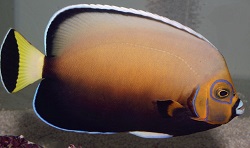 Identification: The Conspicuous Angel occurs from the southern Great Barrier Reef to the central New South Wales coast and from New Caledonia, Norfolk and Lord Howe Islands. They grow to about 12 inches so they are for the largest of aquriums only. Also called the Spectacled Angelfish, aquarists think of the Conspicillatus as a highly prized species in the aquarium trade. They come from the deep waters around Lord Howe Island in Australia, found on coral and rocky reefs down to a depth of 40 meters, juveniles live in shallower water in protected harbours and bays. This gorgeous fish commands a high price. Recently a 4-inch wild-caught individuals sold for nearly $4,000 online, and the captive-bred Conspicillatus fish are selling currently for over $6,000. The captive-raised Conspicuous Angel do very well in captivity, but the wild-caught Conspicuous Angel (especially large specimens that are accustomed to a diet of live sponges and tunicates) do not have the greatest track record when it comes to long-term survival. As juveniles these fish are quite dull coloured. But once an adult they become a super showfish. They have an orange mask with blue ring around the eye and two blue lines on gill covers, a dark body with pale blue margins on both the dorsal and anal fins, ventral fins are also pale blue. Finally they have a yellow tail with oval shaped black bars at their rear and an orange streak on their pectoral fins. . TankRecommendations: Like all other angelfish it's hermphroditic and the most dominant fish will turn into a male when there is no other male around. These fish are quite peaceful but be careful combining them with fish a lot smaller or larger and other (dwarf)angelfishes. Food and diet: In nature, sponges and tunicates are an important part of their diet. Wild specimens acclimated easiest in a tank with a lot of sponges and live food. Tank bred specimens are famliair with dry food and are much easier to wean on frozen and dry food. These fish aren't considered reef safe and you need to be especially careful with ornamental sponges, LPS, tube worms and clams. Keeping them well fed seems to reduce the risk so make sure to feed them a proper varied diet of algae and meaty foods to make them really happy! In the aquarium feed a diet with a wide variety of vegetable materials. Provide foods that have sponge material and Spirulina in the formula. The quality of the food is important and any flake or pellet foods you choose should contain sponge material and Spirulina. They love Nori and will eat the various colors of dried algae sheets, and frozen preparations. They can also be offered fresh uncooked broccoli which will provide them with vitamin A and C. Adding caulerpa to the tank is also appreciated. There are several good commercial foods available as well, including Formula II and Angel Formula. You may also supplement their diet with a very small amount of meaty fare such as brine and mysis shrimps, along with finely chopped marine flesh. Use meaty foods sparingly. If you have carnivorous fish housed with this angelfish, feed the tank with vegetable based foods first to give the angelfish their fill. Then when meaty foods are added the angelfish will be pretty full and will not consume high levels of meaty foods. Feed several small meals a day, rather than one large meal daily. Offer 2 to 3 feedings a day with only an amount that can be consumed in about 5 minutes. Left over food should be removed to keep water quality high. Level of Care: Moderate Acclimaton Time: 5+ hours Reef Compatibility : Yes |
|
|
|
|
|
|
Copyright 2021 Aquarium Creations Online Photos are representative of each species. All marine life will be unique and variations should be expected, colors and sizes may vary. *Guarantee Restriction: All of our livestock are guaranteed. However for one or more of these species, they may be marked with a *Guarantee Restriction. If it does, it means the specific animal may not handle stress from environmental conditions well. These stresses can include poor water quality, harassment from tank mates or confined aquarium conditions. When stressed, these species can lose the ability to ward off infection and disease. Other species may be listed as Restircted because they have such specialized feeding requirements that is difficult recreate in a aquarium and may succumb to mal nutrition. |